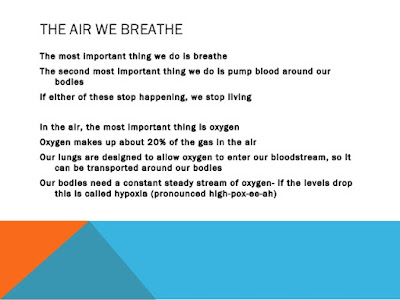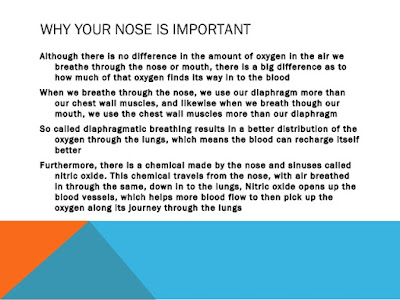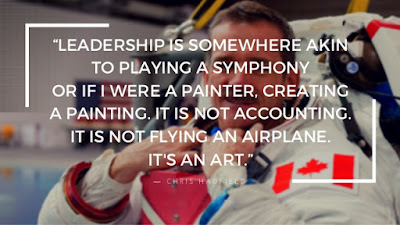The Air We Breathe - Mouth Breathing
The Air We Breathe - Mouth Breathing
THE AIR WE BREATHE
The most important thing we do is breathe
The second most important thing we do is pump blood around our bodies
If either of these stop happening, we stop living
In the air, the most important thing is oxygen
Oxygen makes up about 20% of the gas in the air
Our lungs are designed to allow oxygen to enter our bloodstream,
so it can be transported around our bodies
Our bodies need constant steady stream of oxygen- if the levels drop,
this is called hypoxia (pronounced high-pox-ee-ah)
The Air We Breathe - Mouth Breathing
HOW THE LUNGS WORK
Our lungs need to be inflated to fill up with a fresh lot of air
This happens by the action of muscles around the chest wall,
and most importantly a muscle called the diaphragm,
that all work to stretch the lungs open, sucking air to our bodies.
Once the air is drawn in, it comes into very close contact with blood
that has been pumped into the lungs by the heart.
The right side of the heart pumps blood in to the lungs,
and the left side of the heart pumps blood to the rest of our body.
So the system is designed such that blood low in oxygen is pumped by
the right side of the heart, to the lungs to be recharged with oxygen,
and from here it goes to the left side of the heart,
and is then pumped to the rest of the body.
The brain controls all of this to keep everything organised
The Air We Breathe - Mouth Breathing
IT'S ALL ABOUT THE OXYGEN
As mentioned, the body needs a steady flow of oxygen to function properly
If it starts to miss out one even just a little bit here and there it causes problems
There are different types of low oxygen and the one most important
to this presentation is the type where there are very brief drops
in the oxygen level below normal,
with these dips being very regular all be it short lived.
A drop in oxygen levels is known as hypoxia,
and brief dips are known as intermittent hypoxia.
When intermittent hypoxia has been going on for a while,
it is called chronic intermittent hypoxia.
A dip in the oxygen levels results in a body reaction called inflammation
and this can cause damage to the tissues of the body
The Air We Breathe - Mouth Breathing
WHY YOUR NOSE IS IMPORTANT
Although there is no difference in the amount of oxygen in the air
we breathe through the nose or mouth,
there is a big difference as to how much of that oxygen finds its way in to the blood.
When we breathe through the nose,
we use our diaphragm more than our chest wall muscles,
and likewise when we breath through our mouth,
we use the chest wall muscles more than our diaphragm.
So called diaphragmatic breathing results in a better distribution
of the oxygen through the lungs,
which means the body can recharge itself better.
Furthermore, there is a chemical made by the nose and sinuses called nitric oxide.
This chemical travels from the nose, with air breathed in through the same,
down to the lungs, Nitric oxide opens up the blood vessels,
which helps more blood flow to then pick up the oxygen along its journey
through the lungs.
The Air We Breathe - Mouth Breathing
WHAT LOW OXYGEN DOES TO YOUR BODY
Chronic Intermittent hypoxia affects every body organ you can think of
For example, it makes the heart have to work harder to make up
for the reduced oxygen levels in the blood.
And the brain gets triggered in to a panic mode to be on the alert-
and this affects your sleep quality, concentration, behavior, and emotions,
all for the worse,
And it makes your skin age prematurely, and your blood pressure go high,
your eyesight deteriorate, your bones become weaker,
your immune system changes, your body hormones become erratic,
your appetite increases, you are more likely to end up with diabetes....
And the list goes on.
The Air We Breathe - Mouth Breathing
MORE ABOUT INFLAMMATION
Inflammation is not a disease but a description of a bodily reaction
It can be triggered by infection, trauma, and stress
Stress can be physical, emotional, and psychological
Inflammation is a process that is mediated by the body's immune system.
In people with chronic intermittent hypoxia, we can measure this over-activity.
It is this inflammatory response at a local tissue level
that causes all the problems for the body systems.
The Air We Breathe - Mouth Breathing
WHAT CAUSES A BLOCKED NOSE
The nose starts at the nostrils, goes through the nasal passages,
and into the open space at the back of the nose,
and this then leads down the back of the throat to the voice box,
wind pipe, and lungs.
So the nose can be blocked because there is a problem with the nostrils,
a problem inside the nasal passages, or a blockage in the space behind the nose
Whilst there are lots of things that can cause this,
the 3 most common things are:
1. The adenoids in the space behind the nose are too big
2. The middle part of the nose known as the septum is crooked (deviated septum)
3. The swellings inside the nose known as turbinates are too big.
The Air We Breathe - Mouth Breathing
HOW TO FIX A BLOCKED NOSE
Unblocking a nose is a glorified plumbing job
The easiest way to look at it is based on the 3 main causes:
1.Large adenoids- quite simply, the only thing that works is surgical removal;
we used to think nasal sprays would help,
but the more recent research on this has cast doubt on that notion.
2. Deviated septum- this is a structural problem,
and the only thing that fixes it is surgery.
3. Large turbinates- these may shrink with nasal steroid sprays or
otherwise require surgery to trim them down to size.
So lets go through the basic details of surgery
The Air We Breathe - Mouth Breathing
REMOVING THE ADENOIDS- ADENOIDECTOMY
The adenoids sit at the back of the nose,
so the only 2 ways of seeing them are wither with a telescope through the nose
or using a telescope or mirror placed inside the mouth at the time of surgery.
The historical approach of removing adenoids though,
is to not even look at them- this is called blind scraping or "curettage".
The research on blind scraping shows a high rate of adenoids being left behind,
and sometimes so much can be left behind,
there is still a blockage present.
Newer techniques mean that the old style blind curette approach
has a limited role in modern surgeon's hands.
An adenoidectomy can be performed in isolation or in conjunction
with other ENT surgery
and can be done for reasons other than airway obstruction.
The post-op recovery is usually pretty straight forward.
The Air We Breathe - Mouth Breathing
STRAIGHTENING A CROOKED SEPTUM-SEPTOPLASTY
The middle part of the nose may be crooked in as many as 20% of people.
When it comes to fixing it, if it is a simple deviation,
then this can be done entirely on the inside of the nose,
with no cuts on the outside.
If the septum is severely deformed, or the outside of the nose is also deformed,
then an approach that requires an incision to be made on the outisde of the nose
may be necessary- this is called an open, or external, septorhinopiasty.
In modern surgeons hands this is a day surgery procedure more often than not,
and may be performed in conjunction with other surgery
such as on the turbinates or sinuses.
The post-op recovery is variable, depending on the degree of surgery
required and other procedures performed at the same time.
The Air We Breathe - Mouth Breathing
SURGERY FOR LARGE TURBINATES
In the mainstay, there are 3 types of operations
to reduce the size of the nasal turbinates:
1. Cautery - this is simply the application of an electrical burn to the tissue
which results in the formation of scar tissue,
which shrinks the turbinate down; it tends to only last 6-12 months,
so it is useful for little kids where other procedures are harder to perform
due to the small size of their nose
2. Cobiation turbinate reduction- this is the use of a special instrument
that generates a plasma field; this results in tissue melting away
and tends to last 2-5years,
and it is well suited again for their children where the access is possible.
3. Micro-debrider assisted turbinate reduction- this is the gold standard
for surgery as it physically removes both soft tissue and the supporting bone,
to truly open up the space within the nose:
it is the go to operation for adults and kids that are appropriately selected.
The Air We Breathe - Mouth Breathing
WHAT NOT TO DO IF THE NOSE IS BLOCKED
Sometimes the best of intentions are misplaced
As a starting point, it is important to realise that 80% of the time,
a person is breathing through their mouth because there is a physical obstruction
of some sort to nasal breathing.
As result of this, it is important that the cause be identified-remember,
mouth breathing is merely an observation, not a diagnosis.
When it comes to management strategies, there are 2 things to absolutely avoid
until an ENT has checked out the breathing:
1. Breathing exercises to force someone to breathe through their nose.
2. Taping the lips closed at night (and this should probably never be done ever)
If nasal breathing is forced against obstruction,
it may result in ever worse inflammation,
which is not a good thing for the body.
The Air We Breathe - Mouth Breathing
WHEN TO FIX A BLOCKED NOSE
People often wonder when they should get their kids or themselves sorted.
The short answer is as soon as a problem is identified.
Kids are not supposed to snore, mouth breathe, or for that matter grind
their teeth at night; these are all potential symptoms of airway
obstructions and this needs to sorted out immediately.
When it comes to adults, some notice a problem and some have such
long standing basal obstruction they have become used to it
and so not realise just how bad they truly are; so if you snore,
mouth breathe, notice you are not getting good quality sleep,
waking up tired, or have limited exercise capability,
then you may have an underlying issue with nasal obstruction.
So in short- if it's broke, fix it!
The Air We Breathe - Mouth Breathing
WHAT TO DO WHEN BREATHING CONTINUES
Sometimes once the nose is unblocked, the patient does not transition
to using their newly created breathing option.
Now often with time things will sort themselves out,
but where this is not the case,
then it may be necessary to engage the services of either a speech therapist
or a my-functional rehabilitation specialist.
The best anology is if you break your leg-being stuck in a cast leads to muscle disuse,
and then require a physiotherapist to get things sorted
once the cast comes off-well the same applies to breathing.
Having said that, it is a bit different to breaking your legs as more often than not,
nasal breathing will evolve within about 3 months
from surgery-nobody is really sure at what time point breathing therapy
should be started due to this being the case,
so that is something to discuss with your surgeon as to their own experience.
The Air We Breathe - Mouth Breathing
ASSOCIATE PROFESSOR DR DAVID MCINTOSH
Ear, nose and throat specialist
Specialist in paediatric ENT, nose and sinus disease,
and upper airway obstruction.
Contact details:
Phone 07 5451 0333
Facebook ENT specialists Australia

















If you want to make sure that you are breathing correctly, you absolutely need to invest in a simple nasal breathing treatment by face by fisher. We all know that nose breathing is healthier, but many of us are poor nose breathers. If you want to make sure that you are getting the most oxygen possible, this is the treatment for you! The fisher face mask is one of the most advanced nasal breathing treatments on the market. You can't find a more effective or easier to use treatment. The mask is easy to put on, treat yourself once every day for fifteen minutes and you are on your way to better breathing!
ReplyDelete